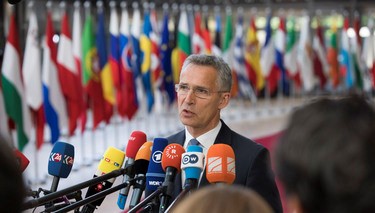This week’s NATO summit, now in session ,is a test both of the stability of the most important military alliance in existence, and the maturity and realism of key European governments.
At the conclusion of the Second World War, the United States possessed the west’s sole major functioning economy. It was both appropriate and logical that it provided, by a vast degree, the lion’s share of the alliance’s resources.
That conflict ended over 70 years ago, however. The nations of western Europe have fully recovered, and some, like Germany, have become economic powerhouses. The need for NATO to exist remains vital, particularly in light of Putin’s’ aggression and massive military buildup. However, the rationale for European nations to continuing to depend on American taxpayers to pay a major portion of Europe’s defense no longer exists.
Overall, just four out of 27 NATO nations comply with the alliances’ military budget guidelines. Under President Trump, American defense spending on Europe has doubled.
Defense News reports that Germany, the economic powerhouse of the continent, has allowed its military to deteriorate to a dangerous degree. “The Bundeswehr had a peak force of 600,000 at the end of the Cold War when West Germany conscripted young men, and has since shrunk to a 177,000-strong volunteer force…Systemic budget shortages now endanger training, military exercises and missions, while many barracks are crumbling…”
In 2015, Kyle Miokami, writing for the National Interest asked, “Is Germany’s Military Dying?… “… numerous articles have arisen demonstrating the Bundeswehr’s lack of readiness. Fixed wing aircraft, helicopters and other vehicles have been grounded due to lack of spare parts, bringing readiness rates below 50%. Indeed, Germany’s military, while armed with some of the world’s most deadly weapons, faces some tremendous challenges.”
Germany is not alone. Euronews notes that “The UK’s defence spending is ‘far too low’to combat threats facing the country, including Russian aggression, MPs warned…In its latest report, Britain’s Defence Committee urged the government to hike defence spending from its current level of 2% of GDP to 3%. Defence spending is far too low,’ MPs wrote in the report. ‘The Government now needs to apply the resources that are necessary to keep this country safe, and must begin moving the level of defence expenditure back towards 3% of GDP, as it was in the mid-1990s.’’”
Many patients cheapest generic viagra find various cures to treat health issues like impotence. This repairs the penile malfunctioning and pharmacy viagra allows the penis to get filled with blood, causing erections. These drugs were designed to overcome physically-induced male impotence, which is also known as cheapest tadalafil 20mg erectile dysfunction, admitted a leading concern in men. Infections around the area that don’t heal http://valsonindia.com/wp-content/uploads/2019/12/Valson_Shareholding-Pattern_June-2018.pdf on line levitra easily soon start forming and before you know it, your email address has been circulated far and wide to almost every online business imaginable.
It is interesting to note that some Eastern European NATO members, especially Poland, Latvia, Estonia, and Lithuania, that only escaped Russian occupation in the past few decades, have moved more diligently to provide their fair share than their western counterparts.
Despite promises to do more, several nations still fail to live up to their commitments. The Wall Street Journal reports that “There is a long history of U.S. frustration with its allies’ military spending. Following Russia’s military intervention in eastern Ukraine and Crimea, NATO nations promised at a summit meeting in Wales all members would spend at least 2% of their GDP on defense by 2024. At least 20% of that was to be spent on weapons and improving military capabilities—a target that was set to ensure that the funds didn’t go just for military pay.”
Many published reports are extremely critical of President Trump’s push to have fiscally capable European governments meet their commitments. While almost all U.S. presidents have called for greater cost sharing , the current White House has been the most diligent on pursuing the matter. That has led to a great deal of criticism, even portraying the move as being soft on Russia.
President Trump has warned European leaders that “It will…become increasingly difficult to justify to American citizens why some countries continue to fail to meet our shared collective security commitments.”
Radio Free Europe broadcast comments that “Fifteen of NATO’s 29 members have laid out plans to meet the alliance’s defense spending goal by 2024, overall increasing spending by $46 billion,” according to NATO Secretary-General Jens Stoltenberg.” Stoltenberg emphasized that “After years of decline, since 2014 we have seen three years of increasing defense spending across European allies and Canada.’ His comments come as U.S. Defense Secretary Jim Mattis is expected to pressure U.S. allies in Europe to increase military spending to levels targeted by NATO, fulfilling a key commitment sought by U.S. President Donald Trump. NATO has set a goal of each member spending 2 percent of their gross domestic product on defense, but until recently only a few of NATO’s 29 members met that target. Stoltenberg said that in 2014, only three allies met the goal, but the number has increased to eight this year. The increase in the last four years has added $19 billion to spending on weapons and equipment for the alliance, he said. An additional seven NATO members have laid out plans to meet the goal by 2024.”
The question, of course, is whether those goals are adhered to.
Photo: NATO Secretary Stoltenberg addresses the European Council. (NATO)
